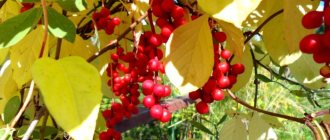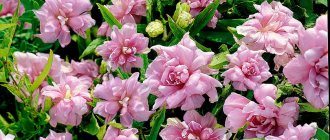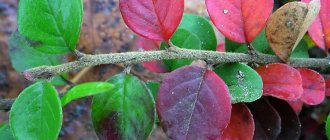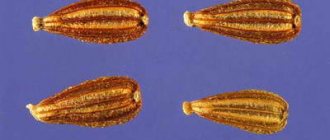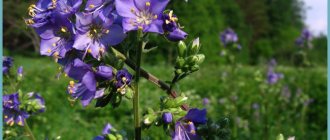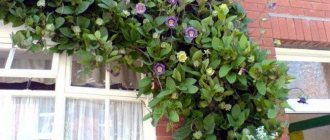Actinidia is a liana native to the Far East. Its fruits resemble kiwi in taste - and it is no coincidence: the predecessor of this exotic fruit was Actinidia sinensis, and kiwis themselves grow on Actinidia deliciosa, which in Russia ripens only in Sochi and Crimea.
Other types of actinidia easily adapt to different climatic conditions. However, most of these vines are able to grow in the middle zone. Actinidia grow well in the Moscow region.
The fruits of Actinidia are consumed fresh, and in addition, they make excellent homemade preserves - compotes, jam, marmalade.
Actinidia species
Such a well-known fruit as kiwi, sold in any vegetable retail outlet, is the fruit of Actinidia chinensis - an exclusively heat-loving crop that is not able to germinate in our frosty conditions. However, gardeners with extensive experience are still trying to find a way to create conditions for its germination in our latitudes. The difficulty of caring for the rather labor-intensive actinidia chinensis lies in creating a shelter. The three other varieties below are more cold-hardy.
Actinidia berries
Kolomikta
Grows in its natural environment in the Far Eastern region. It has good resistance to frost, characteristic of the middle zone, which makes it possible to plant and care for actinidia in the Urals.
The minimum temperature at which Kolomikta can continue to develop actinidium in the Urals is -44°C. However, spring temperature changes have a negative effect on the plant.
The maximum height of the bush is 5 meters. The average diameter of the trunk thickness of a fully formed plant is 5 centimeters. The color of the shoot is red-brown. Actinidia Kolomikta is distinguished by the appearance before the transition to the flowering stage of variegated leaves of a whitish-crimson color. The size of the flowers, which have an unusual lemon-lily of the valley aroma, is small. The flowering period begins at the end of spring. When ripe, the berries fall to the ground.
Fruiting bush
Arguta
The height of the productive Argut actinidia shrub can reach more than 10 meters. The frost resistance indicator of this species is relative. Rare varietal varieties are capable of continuing life activity in conditions where temperatures drop below -30°C. The average limit of cold resistance of Argut actinidia is -27°C. In the Moscow region and central Russia, the temperature does not drop to this level every season, but once every 10 years such conditions occur in our country.
The leaf size of Actinidia Arguta is larger than average. The diameter of flowers that do not have a scent is 3 centimeters. The average quantitative yield indicator is 14 kilograms. Ripe fruits do not fall off.
Helpful information. The taste of the fruits of Actinidia Polygamy can be described as a mixture of figs and sweet pepper.
Polygamous
The height of the Actinidia Polygamy vine is 5 meters. This species originated in the Far Eastern territory. The color of the shoots is light brown. Actinidia Polygama has relative cold resistance - the minimum temperature at which the plant is able to continue bearing fruit is -31°C. However, shoots that have not completed the growing season are susceptible to freezing.
Note. The frozen shrub of actinidia Polygamy independently restores its vital functions.
The color of the fruits of actinidia polygamy is yellow. The size of large leaves is 14 centimeters. Variegation, characterized by the acquisition of silver-colored foliage, persists until the berries are fully ripened.
Important! To place the Actinidia Polygamy vine in a shelter, it must be removed from the trellis.
Appearance of berries
The list of the State Register of our country in the field of breeding achievements presents more than 4 dozen varietal names of actinidia, planting and care in the Moscow region can be carried out, as well as those aimed at cultivation in certain regions of Russia.
Often, the choice of actinidia is the best varieties for the Moscow region, the cultivation of which is limited exclusively to samples of planting material presented in nurseries. Since many seedlings are purchased abroad, most of them do not take root in our climatic conditions.
Why is Chinese actinidia called kiwi?
The classic kiwi that we see on the shelves of our grocery stores is none other than actinidia sinensis or actinidia deliciosa. Another common name is Chinese gooseberry.
Today, kiwi is exported to Russia from countries that have regions with a subtropical climate - Greece, Italy, New Zealand, Chile.
It is interesting that experimental plantations already exist in Russia. They are located on the Black Sea coast of the Krasnodar Territory and in the southern part of Dagestan.
Varieties for cultivation
Important! To make it possible to grow actinidia in the Moscow region and other areas of central Russia, only domestic hybrid varieties of actinidia are suitable.
Actinidia: planting and care
List of varieties of actinidia Kolomikta:
- Grape is a cold-resistant, medium-yielding varietal actinidia. The transition to the ripening stage occurs at the beginning of August. The weight of one olive green berry is 2 grams. Gastronomic characteristics – sweet and sour taste and apple aroma;
Helpful information. The berries of the Actinidia variety for the Moscow region Vinogradnaya contain a large amount of vitamin C.
- Graceful is a winter-hardy variety of actinidia. This variety of actinidia is grown in the Urals, planting and caring for which is carried out based on varietal characteristics. The 4-gram fruits ripen in the second half of August. Gastronomic characteristics - sweet and sour taste and aroma of pineapple. Good disease resistance;
Helpful information. The fruits of Actinidia Graceful contain the highest concentration of vitamin C among other varieties of this crop.
- Marmalade is a medium-winter-hardy, late-ripening variety of actinidia. The color of the 3-gram berries is olive green, sometimes with a reddish tint. Gastronomic characteristics – very sweet taste and strawberry aroma. High content of vitamin C.
List of Argut actinidia varieties:
- September is a mid-late variety of actinidia. The weight of dark green berries is 10 grams. The gastronomic characteristics of this variety are a slightly sour taste and aroma of pineapple. Low vitamin C content;
- Mikhnevskaya is a mid-late variety of actinidia. The gastronomic characteristics of a 10-gram berry are the sweet and sour taste and aroma of pineapple.
List of varieties of actinidia Polygam:
- Zlata is a mid-late fruitful varietal actinidia. Orange fruits weigh on average 5.5 grams. The taste is reminiscent of a mixture of figs and sweet pepper;
- Lesnaya is a variety that has an identical description to the Zlata variety, but the average weight of its berries is 7 grams;
- Ostropryannaya is a late-ripening variety of actinidia. The color of the 3 gram berries is dark orange. The fruit tastes like hot pepper.
Interesting fact. The maximum fruiting period for actinidia in a permanent place can be almost a hundred years.
Diseases and pests
The plant has good immunity, but if the site for planting is chosen incorrectly and care is taken incorrectly, it can be affected by spots ( phyllosticosis, ramulariasis ), powdery mildew , mold microorganisms and rot .
Plants should be inspected regularly for signs of disease.
Signs of actinidia diseases are the appearance of gray or black spots on fruits and leaves. At the first signs of illness, the following measures should be taken:
- spotting can be removed by 2-3 treatments of the plantings with Bordeaux mixture ;
- to treat powdery mildew, bushes need to be pollinated with ground sulfur , then sprayed with a solution of soda ash ;
- Rot and mold are very difficult to remove, so you need to regularly remove the affected branches and fruits and burn them, and after the plants have shed their leaves, treat the soil with antifungal agents.
Of the insect pests, the greatest damage to vines is caused by leaf beetles , butterfly larvae , longhorned beetles and bark beetles . You can fight them with the help of special preparations - acaricides and insecticides.
Berries that look like miniature kiwis can be consumed in any form.
With proper care, actinidia kolomikta produces a rich harvest of fruits that contain many useful substances. They can be eaten fresh, dried, made into preserves, jams and marmalades, and the leaves and bark are used in folk medicine to make medicines against colds and inflammatory diseases.
Therapeutic recipes using actinidia
By spending a little time and effort growing this amazing plant, you can get not only a beautiful garden decoration, but also a tasty and healthy addition to your diet.
Preparing the landing site
Actinidia, on average, is capable of bearing fruit in one place for half a century. It is necessary to plant plants of both sexes on the site, which is due to the fact that actinidia is a dioecious plant that requires cross-pollination. Typically, for every 5 female plants, 1 male plant is planted. The type of trellis for actinidia vine is a grape stand.
Honeysuckle: planting and care in the Moscow region
Within the middle zone, actinidia is planted in a place protected from the wind, on the south side of a residential building. It is necessary to maintain a sufficient level of soil moisture. In hot weather, the plant is sprayed twice a day.
Important! Planting actinidia next to trees is unacceptable, as this will lead to dehydration of the soil.
Features of the soil for planting actinidia in the Moscow region:
- the groundwater level should not exceed 1 meter;
- neutral pH;
- loamy, high humus content;
- well-drained soil;
- increased potassium content.
How to distinguish a male actinidia plant from a female one
During the first flowering, the sex of the vines can be determined by the flowers:
- On female plants the flowers are solitary; in the center of the flower there is a large pistil with a rounded ovary, a style and star-shaped stigmas.
- On the male ones, two or three are collected in inflorescences, which are located in the axils of the leaves on the shoots of the current year. Inside the flowers on male bushes, numerous stamens with anthers on thin filaments are visible.
The photo shows male and female actinidia flowers.
And although the female flowers are bisexual in structure, they are adapted to cross-pollination by air and with the help of bees and bumblebees. Faded staminate flowers fall off, and in pistillate (female) flowers the ovary enlarges and a fruit is formed.
Actinidia species do not cross-pollinate with each other
The right time to disembark
Blueberries: planting and care in the Moscow region
Note. Actinidia is planted in the spring, but it is permissible to carry out planting work in the fall, 2 weeks before the cold snap.
Important! The slightest deformation of the root system should be avoided, since the plant is not always able to tolerate even a 10-minute stay in the air with exposed roots.
The best option would be to transplant a mature seedling from a container. The age of planting material should not exceed 3 years.
Note. It is not recommended to plant the plant in hot weather.
When planting, maintain approximately a 3-meter distance between plantings.
The root system of actinidia lianas grows in a horizontal direction. The shallow planting hole must be well drained to avoid stagnation of liquid. The following materials can be used to make drainage:
- brick fragments;
- pebbles;
- coal slag.
Step-by-step instructions for planting:
- 2 weeks before planting, create a 50-centimeter depression with a diameter of 44 centimeters;
- Set aside topsoil;
- Lay drainage in a 10-centimeter layer;
- Mix the top layer with a bucket of humus;
- Fill the hole with a bucket of water;
- Wait until the soil settles;
- Water the seedling in the container;
- Remove the seedling, avoiding deformation of the root system;
- Make a small mound of clean soil;
- Install the seedling;
- Cover with planting mixture;
- Water the plant;
- Mulch the ground;
- Protect the plant from pets;
- Create shady conditions for 2 weeks.
Note! It is unacceptable to introduce fresh mullein and lime into planting holes.
Self-pollinating actinidia: truth and fiction
All types of actinidia are by nature dioecious plants; their female and male flowers are located on different specimens. The flowers are honey-bearing and pollinated by bees. The stamens present in female flowers have low pollen quality, insufficient for complete pollination. There are partially self-pollinating varieties in which individual female flowers bear single berries from their own pollen. But with normal cross-pollination, their yield will be several times higher and the berries will be larger. Some seedling sellers are silent about these features, deliberately or unknowingly omitting the word “partially” in the description of such partially self-pollinating varieties.
In amateur gardens, the illusion of self-pollination sometimes occurs if a single female actinidia plant is pollinated by a male specimen of the same species growing in a neighboring plot.
How to care in the Moscow region
For actinidia, drying out of the soil and arid air is unacceptable - this leads to the beginning of the shedding of foliage and freezing of unripe shoots with the onset of frost.
Watering is carried out weekly in the amount of 5 liters of water per formed bush. Planting legumes under it will have a good effect on actinidia.
Actinidia in section
Timing for fertilizing actinidia:
- with the beginning of spring, a 20-gram dose of potassium-phosphorus fertilizers and 35 grams of nitrogen fertilizer are applied per 1 m²;
- when the ovaries are formed, a 10-gram dose of potassium-phosphorus fertilizer and 15 grams of nitrogen fertilizer are applied per 1 m²;
- at the end of September, a 20-gram dose of potassium-phosphorus fertilizers is applied.
After applying dry fertilizers to a 7-centimeter depth, the plant is watered.
Note. Once every two years, a bucket of humus should be added under the bush.
How to propagate actinidia
Note! It is not recommended to propagate actinidia by seeds.
Available methods of propagation of actinidia:
- Propagation by layering involves pinning a shoot to the ground, after which it is covered with a 10-centimeter layer of soil. The upper part of the shoot is located outside. The shoot area is mulched. Rooting is carried out at the end of summer;
- For cuttings, young 10-centimeter shoots are taken in early June. The upper straight cut is placed at a 3-centimeter distance from the kidney. The measure of the lower cut is slightly more than 40°. The lower part of the foliage is removed. Planting of cuttings is carried out at a 60° angle with depth to the middle bud. The shelter is made from non-woven fabric. Spray 10 times a day. Cover with fallen leaves for the winter.
Molding of actinidium vine
You can start shaping the bush in the third year after planting, exclusively in the summer. Formed in the form of a two-arm cordon. When pruning Kolomikta and Polygamy, fruiting on long shoots is taken into account. Young shoots are pruned by a third. Anti-aging pruning is carried out after 10 years of germination.
Note. There is no need for anti-aging pruning for Arguta.
Green fruits
Botanical description and features
The decorative nature of the tree-like vine (sometimes the trunk diameter reaches 6 cm) is explained by its luxurious color scheme, which changes during spring, summer and autumn.
At the beginning of spring, shoots with bright golden leaves appear; as they grow, they change color to green, and just before flowering, the tips of the leaves turn white. The metamorphosis with coloring does not end there. After flowering, they gradually turn pink and turn scarlet. The coming autumn will add its own colors, and the vine will amaze with the intensity of shades: pink, yellow, purple. The sunny the place chosen for the plant, the brighter the riot of colors.
Thin, oblong, oval leaves are attached to the trunk by petioles, sometimes reaching 5-7 centimeters. The leaves sometimes grow up to 10-13 cm.
Actinidia blooms with medium-sized white or pinkish fragrant flowers for three weeks. They are collected in compact brushes.
The plant does not bloom until it is 5 years old - the vine is gaining strength. But in the sixth year he will thank the gardener in full. Curly branches, climbing to great heights, will be covered with delicate flowers, beautifully arranged along the entire length. However, fruiting will begin only in the 10th year of life.
Actinidia fruits are medium-sized, bright green with longitudinal stripes, elliptical in shape. The largest ones grow up to 3 centimeters in length. Juicy, sweet, aromatic berries are full of seeds. The harvest is ready at the end of August - mid-September.
Read also: Vitamin bomb - actinidia
There is debate among culture lovers about whether actinidia is self-fertile. Some argue that such varieties do not exist completely, and the plant should be planted at the rate of two males per 5-6 females. However, this statement is not true.
There are species of actinidia that do not require pollinators.
Actinidia care in autumn
After the seasonal harvest of fruits, the plantings are fertilized with phosphorus and potassium. After the leaves fall, moisture-recharging irrigation is carried out.
Adult cold-resistant plants are not covered - instead, the area around the trunk is mulched. Young plants are removed from the trellis and covered with spruce branches, dry leaves or a 20-centimeter layer of peat, under which a rodent repellent is placed. Before covering the vine, it is sprayed with 3% Bordeaux mixture.
Harmful effects
Actinidia diseases in the middle zone:
- Powdery mildew, which can be eliminated by double treatment with dissolved 0.5% soda ash once every 10 days;
- Fungal diseases that are treated with Fitosporin once every 10 days;
- Foliage spotting, which is treated with 1% Bordeaux mixture;
- The leaf beetle is eliminated with a tincture of tomato tops and hot peppers.
Actinidia arguta
Actinidia is a wonderful ornamental and fruit-bearing plant for the Moscow region. The fruits of some varieties of actinidia contain a higher concentration of vitamin C than rose hips. By following simple care requirements, you can grow and harvest a bountiful harvest of healthy berries in the fall.
5 1 vote
Article rating
Features of the plant
Thanks to scientists, varieties have been bred that are capable of growing and bearing fruit in Moscow and the Moscow region. Some plant species are able to survive in the northern regions of the country, such as Siberia or the Urals.
Actinidia looks like a vine with curly branches on which wide heart-shaped leaves grow
The foliage changes color depending on the season. It becomes especially contrasting and rich in autumn. The plant begins to bloom at the end of May for 21 days. The flowers fascinate with their unusual shape and color, which gives off a fragrant smell. You can enjoy the fruits in early September.
What mistakes do gardeners make when planting actinidia?
The most common mistakes:
- When planting, the distance between the bushes is not taken into account . Optimal - 1.5 meters. The minimum is 0.7 meters. Thickening of plantings slows down growth.
- They buy seedlings at markets. In such conditions, there is a danger of acquiring vines of only one sex, without varietal characteristics, etc.
- They are careless about the roots . They are very vulnerable in actinidia. They cannot be kept outdoors. They should be with a lump of earth, in a tightly closed container.
- Planted next to fruit-bearing trees with a massive root system; In such a place, actinidia may die.
Problems and damage to actinidia
Actinidia is not damaged by diseases and insect pests, so no chemical treatments are required.
The only enemy of actinidia is cats. The roots, shoots and leaves of this plant contain chemical compounds that affect most cats in a similar way to valerian and catnip. Young actinidia plants are especially affected by cats. Therefore, immediately after planting, it is necessary to fence the seedlings with a fairly high metal mesh.
To protect against cats, actinidia plants are fenced with a strong mesh.
Possible problems of actinidia (table)
| What does it look like | What is this | What to do about it |
| White or white-pink spots on leaves | Natural coloring, species characteristic of actinidia polygamum and kolomikta | Do nothing, everything is fine |
| In spring, young leaves and buds suddenly turn black and wither, as if burned. | Freeze Damage | After some time, new leaves will grow from dormant buds. Plants planted near the southwestern walls of buildings suffer least from frost. Young vines can be covered with film or agrofibre when there is a threat of frost. On flowering plants, the cover must be removed during the day for pollination. |
| In summer, in hot, dry weather, the leaves wither and dry out. | Lack of moisture | It is best to plant actinidia in partial shade, and when planting in an open place, be sure to provide shade, especially for young plants. Sprinkler irrigation in the evening or early morning will help increase air humidity. During the day, you can’t rain in the sun; wet leaves can cause sunburn. |
| Leaves and shoots are gnawed or completely eaten, grass around plants is crushed, the ground is trampled or dug up | Cats lived here | Immediately after planting, enclose the actinidia with a strong protective net. |
The variegated color of actinidia kolomikta leaves is a normal natural phenomenon.
Is it successfully cultivated in the regions?
The listed varieties are prone to certain requirements, so not each of them will grow equally well, for example, in the north or in the southern regions.
Moscow and Moscow region
Subject to planting conditions and sufficient care, actinidia takes root well in this region and brings stable yields. Various varieties of the kolomikta species feel best here, which can do without shelter, since they are adapted to winter average daily temperatures down to -20 oC.
Leningrad region
Actinidia kolomikta, which is resistant to low temperatures, is also widespread here. The most popular varieties are Lakomka, Sugar, Fantasia, Sladkoezhka, Fairy.
In the middle lane
For this region, varieties are suitable that tolerate a changeable climate with characteristic not very warm summers and frosty winters with frequent thaws. Actinidia kolomikta, which does not require complex care, and argut, which should be covered in winter to prevent freezing, are successfully cultivated here.
On South
In private farms in Crimea there are entire actinidia plantations
The southern climate is especially favorable for growing all types of actinidia. Here they have gorgeous foliage and produce rich harvests. In addition to fruit purposes, actinidia is also grown here as an ornamental plant.
In Siberia
In this region, actinidia is least susceptible to frost due to the late appearance of foliage and the formation of new shoots instead of branches that are frozen. For good yield, the plant must be planted in shaded areas, providing meticulous care. A suitable species for Siberia is kolomikta, in particular its varieties: Sakhalinskaya, Universitetskaya, Priusadebnaya, etc.
In the Urals
The hot summers and snowy winters of the Urals make it possible to grow Actinidia kolomikta here. Winter-hardy varieties of this species perform well during the growing season (from early May to late October) and bring a good harvest, especially: Vafelnaya, Maritsa, Uslada, Robinson, etc.
In the Far East
Two species of actinidia are cultivated in this region: kolomikta and arguta. Moreover, gardeners prefer kolomikta for its ease of care and endurance, especially noting the incredibly sweet varieties (Sladkoezhka, Sugar, Honey).
Specifics of outdoor care
Like any garden crop, actinidia kolomikta needs regular care. During drought, the plant is watered, and before the frosty winter, it is insulated. For better fruiting, feed with organic matter and minerals.
Irrigation and fertilizing
Actinidia is a moisture-loving crop. If there is a long absence of precipitation, you need to water the bush at least once a week. When there is a lack of moisture, the vine sheds its leaves. 2-5 buckets of water are poured under the root.
For normal growth and good fruiting, the plant needs feeding. In the spring and during the formation of ovaries, actinidia is fed with nitrogen, potassium and phosphorus.
In the fall, after picking the berries, so that the crop overwinters well, potassium and phosphorus are added to the soil. Take 35 grams of fertilizer per 12 liters of water.
Mulching the soil
The soil around the plant can be mulched with agrofibre, dry grass, and sawdust. Mulch will reduce moisture evaporation and prevent weeds from breaking through.
Installation of support
Actinidia is immediately planted near a support (arch, arbor), along which it will climb up, or a special trellis is installed later - in the 2nd year of the plant’s life. In the first years, the shoots are directed and tied to a support. Then the plant climbs on its own. The optimal support height is 1.9-2.45 meters.
Trimming
In the second year of the crop’s life, in early spring, before the sap begins to flow, you need to carry out the first pruning: leave 2 main shoots and cut off all the rest. In other years, in late autumn, after the end of leaf fall, the crown is thinned. Formative pruning is not recommended in spring, since during this period the vines have strong sap flow. At 7-9 years old, the old vine is cut off and growth is transferred to the young shoot.
Shelter for the winter
The need for careful shelter before wintering is determined by the type of actinidia and the severity of winter. Winter-hardy varieties and plants growing in temperate climates do not need insulation. It is enough to mulch the ground before winter with a thick layer of peat or dry leaves. In northern latitudes, shoots are removed from their support, wrapped in burlap or agrofibre and laid on the ground. In winter, add more snow to the plant.
Diseases and pests: treatment and prevention
Culture rarely gets sick. Weakened shrubs in rainy and warm weather are affected by fungi. The most common diseases are powdery mildew (white coating on the leaves) and phyllosticosis (dark spots and holes on the leaf blades). For prevention, in early spring the foliage is sprayed with fungicides (Fitosporin-M, Gamair, Topaz, Skor).
In hot weather, plant leaves suffer from aphids, caterpillars, and spider mites. Insects are saved by spraying with a soap-ash solution and insecticides (Fitoverm, Aktellik). Cats love to eat the juice of vines and ripe berries.
Harvesting
Actinidia fruiting:
- With proper care, the first harvest is harvested 3-4 years after planting.
- Full fruiting begins at 7 years of age.
- Duration – up to 40 years.
- Fruits ripen in 2 months. They are suitable for eating.
- The composition contains a large amount of vitamin C.
- During processing, healing substances are preserved.
Ripe fruits have a delicate sweet and sour taste. Soft, similar in cross section to kiwi. They ripen gradually. Store in a cool place for no more than a day. They produce a harvest every year. Collected in August, September.
The effect of actinidia fruits on the body has not yet been studied, so consume no more than 3 pieces per day. Juices, jams, and jelly are made from them. Can be frozen. Combine with lemon and currants. Use fresh, dried.
With proper care, individual bushes produce up to 60 kg of harvest.
Actinidia care after harvest
Young bushes should be covered for the winter, for this:
- actinidia is removed from the support;
- under it they put poison for rodents;
- cover it with fallen leaves, spruce branches, and peat.
The time for shelter is after stable cool weather has established. For the Moscow region - the end of October. They film it no earlier than April, when the temperature is above zero.
Sanitary pruning is carried out in September. After picking the berries, fertilizers must be added.
Propagation options: cuttings and seeds
Planting actinidia kolomikta is a very important step and you need to do everything right. But it is much more important to choose the method of propagating the plant. Propagation options include sowing seeds using the seedling method and cuttings. Let's consider propagation by cuttings and seeds. In general, experienced gardeners also practice propagation using leaves and layering (these are a certain type of shoot).
For propagation by cuttings, it is necessary to select shoots with partial lignification. They take root well and produce strong, strong growth. The branches are cut up to 15 cm long; they should have no more than 3 leaves. Before planting in the ground, the leaf blades are cut in half. Planting is carried out in a special shrub at a distance of 20 cm between the cuttings. The depth of placement is up to 15 cm. The location is inclined. After planting, abundant watering and mulching of the soil surface are carried out. In the first 10 days, film cover and daily watering are required. It takes 3-4 weeks for the root system to form. After this, the cuttings are ready for transplanting to a permanent place of growth.
The following scheme is practiced:
- cuttings are carried out in the first half of June;
- in the school, cuttings are grown until autumn;
- in autumn they are covered with straw;
- replanting is carried out in the spring - immediately after the snow cover melts.
The vegetative method of propagation is possible on those plants where layering is formed. For this purpose, the vine is leaned against the ground and fixed in such a position that the layers are buried in the ground. After 3 weeks, the cuttings are cut off from the central trunk and the vine returns to its usual place.
Growing actinidia kolomikta from seeds is, of course, a very exciting process, but it takes a long time. Seeds should be stratified in the refrigerator for at least 30 days before planting. After this, they are soaked in warm water for 3 days. Then sowing is carried out in boxes with soil. Shoots appear after 20-25 days. The boxes are taken out into the garden in the summer and brought into a warm room in the winter. Planting in a permanent place is carried out 1 year after sowing. The first harvest can be treated 5 years after planting in open ground.
